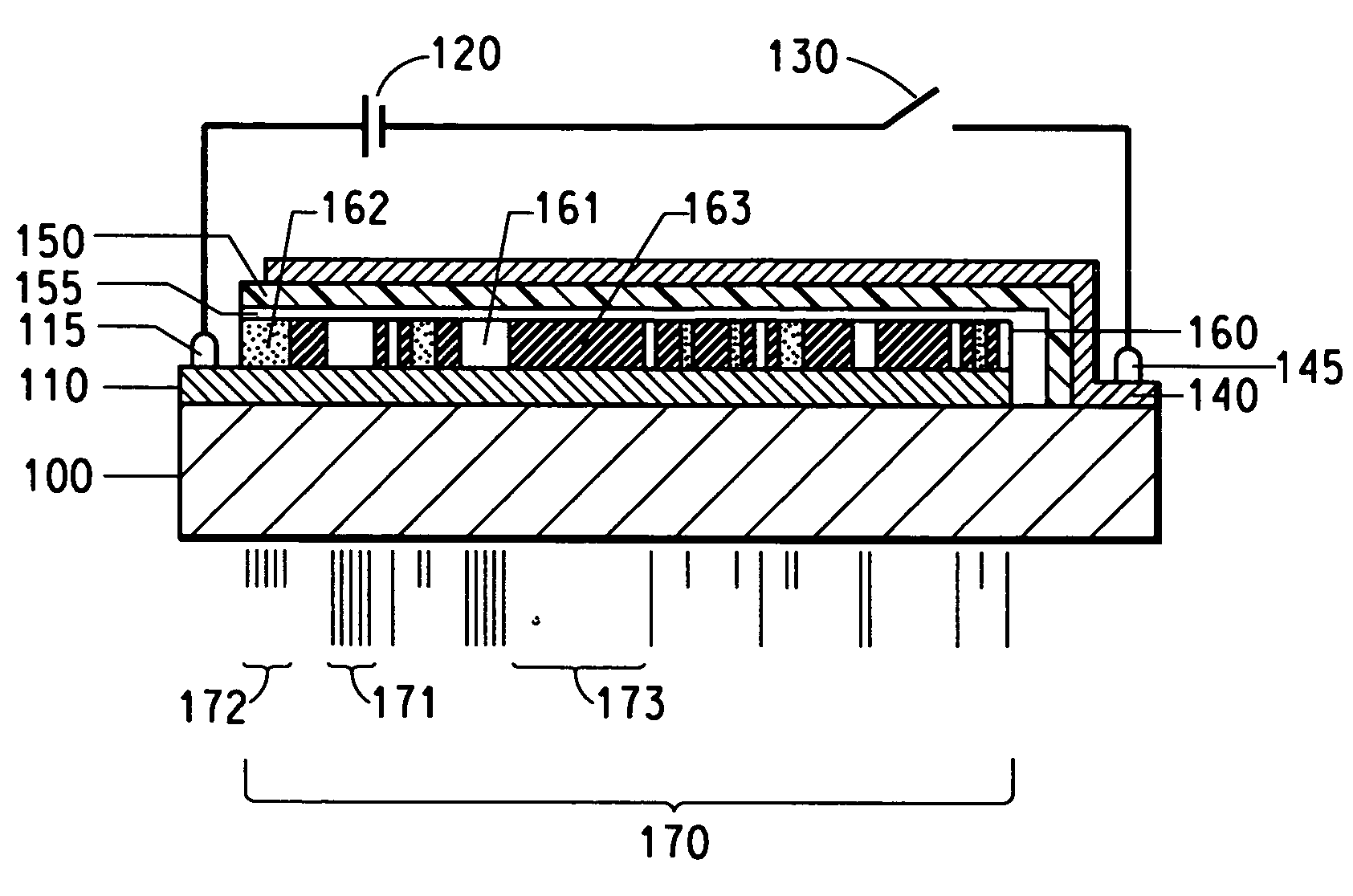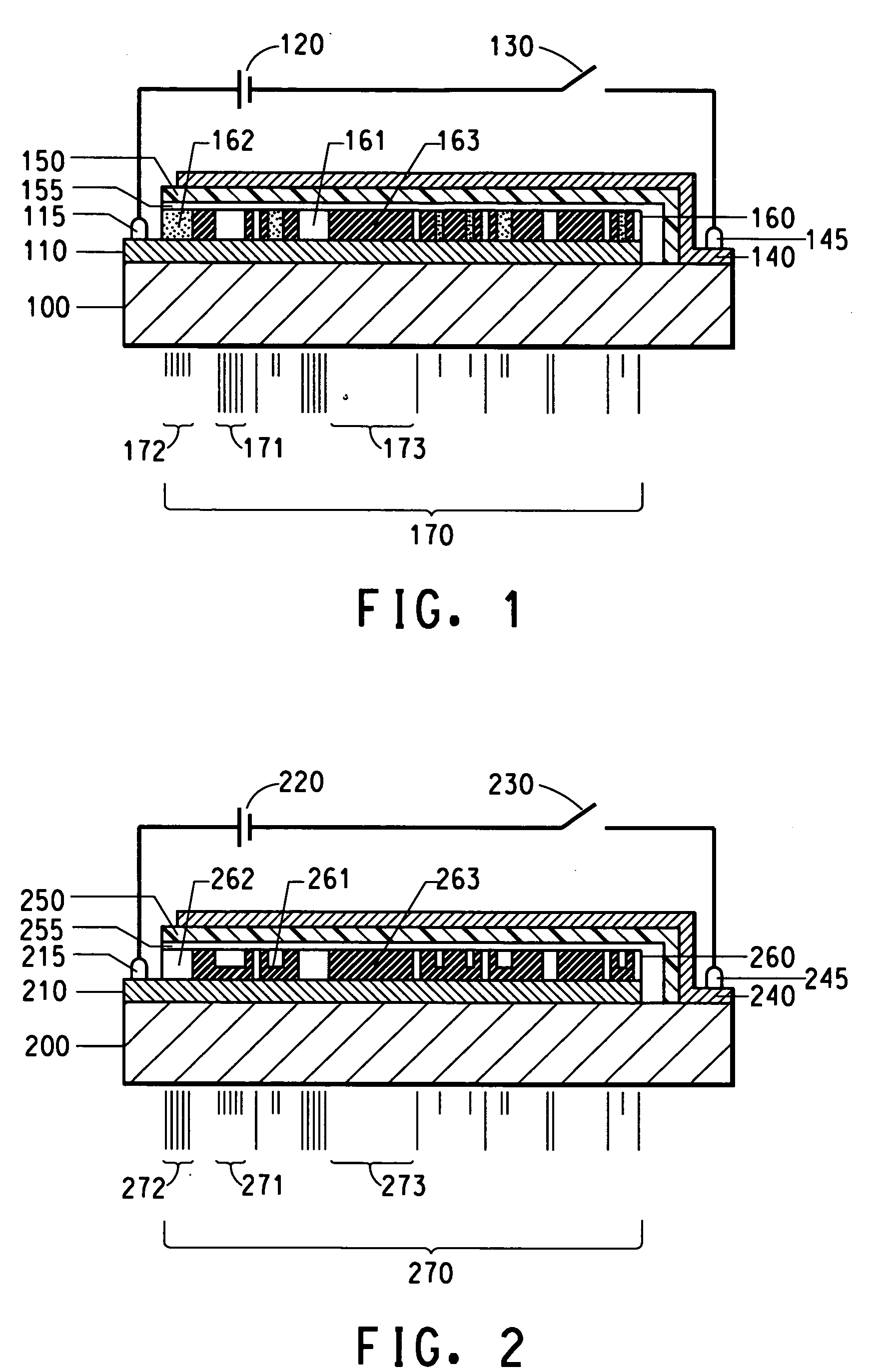Organic electronic device and process forming the same
- Summary
- Abstract
- Description
- Claims
- Application Information
AI Technical Summary
Benefits of technology
Problems solved by technology
Method used
Image
Examples
example 1
[0078] This Example demonstrates selective exposure of an organic resistive layer to varying amounts of a chemical to fabricate a static gray-scale organic light emitting diode array. The result is a device including an organic resistive layer defining a plurality of ionic regions where each of at least three regions are characterized by one of at least three compositions corresponding to discrete resistances that are different from one another.
[0079] Referring to FIG. 1, the substrate 100 is 30×30 mm (nominal) glass and the first electrode 110 is indium tin oxide. The organic resistive layer 160 in this experiment is formed by spin-coating a polyaniline layer. Portions of the spin-coated polyaniline that will not form any of the regions 161, 162, 163 are removed by laser ablation. An ink jet head exposes the second region 162 and the third region 163 of the polyaniline to two different ratios of acetone to propanol, while not exposing the first region 161. The organic resistive la...
example 2
[0080] This Example demonstrates selective removal of varying amounts of an organic resistive layer to fabricate an organic light emitting diode array. The result is a device including an organic resistive layer defining a plurality of ohmic regions where each of at least three regions are characterized by one of at least three thicknesses that correspond to discrete resistances that are different from one another.
[0081] Referring to FIG. 2, the substrate 200 is 30×30 mm (nominal) glass and the anode 210 is indium tin oxide. The organic resistive layer 260 in this experiment is formed by screen printing a carbon / phenolic resistor paste onto the indium tin oxide followed by curing at approximately 150° C. The cured paste is then covered with a lithographic mask having a first set of apertures over the second regions 262 and dry etched to an initial depth. A second set of apertures is then opened in the mask over the first regions 261 and the cured paste in the first regions 261 and ...
example 3
[0082] This Example demonstrates selective blending of varying amounts of components to define an organic resistive layer to fabricate a static gray-scale organic light emitting diode array. The result is a device including an organic resistive layer defining a plurality of electronic regions where each of at least three regions are characterized by one of at least three compositions corresponding to discrete resistances that are different from one another.
[0083] Referring to FIG. 1, the substrate 100 is 30×30 mm (nominal) glass and the first electrode 110 is indium tin oxide. The organic resistive layer 160 in this experiment is formed by ink jet printing a range of blended compositions. An ink jet head prints the first region 161, the second region 162 and the third region 163 using three different ratios of polyaniline to poly(3,4-ethylenedioxythiophene) to tetrathiafulvalene tetracyanoquinodimethane. The portions of the organic resistive layer that will not form any of the regi...
PUM
| Property | Measurement | Unit |
|---|---|---|
| Thickness | aaaaa | aaaaa |
| Electrical resistance | aaaaa | aaaaa |
| Area | aaaaa | aaaaa |
Abstract
Description
Claims
Application Information
 Login to View More
Login to View More - R&D
- Intellectual Property
- Life Sciences
- Materials
- Tech Scout
- Unparalleled Data Quality
- Higher Quality Content
- 60% Fewer Hallucinations
Browse by: Latest US Patents, China's latest patents, Technical Efficacy Thesaurus, Application Domain, Technology Topic, Popular Technical Reports.
© 2025 PatSnap. All rights reserved.Legal|Privacy policy|Modern Slavery Act Transparency Statement|Sitemap|About US| Contact US: help@patsnap.com


